
Euclea, from the Greek eukleia meaning "glory and fame", denotes a group of flowering plants in the Ebenaceae or ebony family. They were described as a genus by Linnaeus in 1774. The genus includes evergreen trees and shrubs, native to Africa, the Comoro Islands and Arabia. Several species are used for timber, producing a hard, dark heartwood timber similar to ebony.
An oneirogen, from the Greek ὄνειρος óneiros meaning "dream" and gen "to create", is that which produces or enhances dream-like states of consciousness. This is characterized by an immersive dream state similar to REM sleep, which can range from realistic to alien or abstract. Many dream-enhancing plants such as dream herb and African dream herb, as well as the hallucinogenic diviner's sage, have been used for thousands of years in a form of divination through dreams, called oneiromancy, in which practitioners seek to receive psychic or prophetic information during dream states. The term oneirogen commonly describes a wide array of psychoactive plants and chemicals ranging from normal dream enhancers to intense dissociative or deliriant drugs. Effects experienced with the use of oneirogens may include microsleep, hypnagogia, fugue states, rapid eye movement sleep (REM), hypnic jerks, lucid dreams, and out-of-body experiences. Some oneirogenic substances are said to have little to no effect on waking consciousness, and will not exhibit their effects until the user falls into a natural sleep state.

Salvadora persica, is a species of Salvadora. Used for centuries as a natural toothbrush, its fibrous branches have been mentioned by the World Health Organization for oral hygiene use.

Vachellia nilotica is a flowering plant tree in the family Fabaceae. It is native to Africa, the Middle East and the Indian subcontinent. It is also a Weed of National Significance in Australia as well as a Federal Noxious Weed in the United States.
Salvia divinorum, a psychoactive plant, is legal in most countries. Exceptions, countries where there is some form of control, include Australia, Belgium, Brazil, Canada, Denmark, Estonia, Finland, Germany, Iceland, Italy, Japan, South Korea, Norway, Poland, Ukraine, Spain, Sweden, Armenia and in 33 states and territories of the United States.

The white-throated robin-chat or white-throated robin is a species of bird in the family Muscicapidae. It is endemic to Botswana, Mozambique, South Africa, Swaziland, and Zimbabwe. Its natural habitats are dry savannah and subtropical or tropical dry shrubland.
Pistacia aethiopica is an African and Arabia coast peninsula species of plant in the family Anacardiaceae. It is a dioecious evergreen shrub or tree of the pistacio genus, growing up to 20 m (66 ft) tall, adapted to the dry environment. It is found in Ethiopia, Kenya, Somalia, Tanzania, Uganda, and Yemen.

Salvadoraceae is a family in the plant order Brassicales, consisting of three genera with a total of 11 known species. They occur in Africa, Southeast Asia, and on Java, suggesting they are probably found in much of Malesia. They are often found in hot, dry areas.
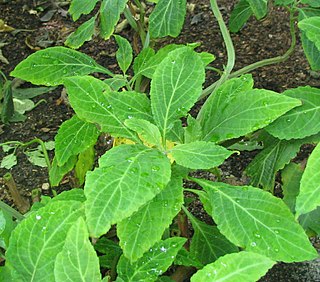
Salvia divinorum is a plant species with transient psychoactive properties when its leaves are consumed by chewing, smoking, or as a tea. The leaves contain opioid-like compounds that induce hallucinations. Because the plant has not been well-studied in high-quality clinical research, little is known about its toxicology, adverse effects, or safety over long-term consumption. Its native habitat is cloud forest in the isolated Sierra Mazateca of Oaxaca, Mexico, where it grows in shady, moist locations. The plant grows to over a meter high, has hollow square stems like others in the mint family Lamiaceae, large leaves, and occasional white flowers with violet calyxes. Botanists have not determined whether Salvia divinorum is a cultigen or a hybrid because native plants reproduce vegetatively and rarely produce viable seed.
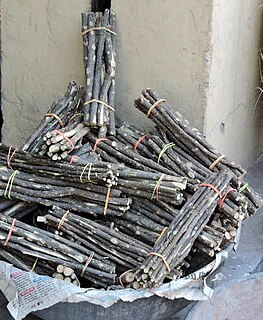
A teeth-cleaning twig is a tool made from a twig from a tree. It can help to prevent tooth decay and gum disease.

Dwarskersbos is a settlement in West Coast District Municipality in the Western Cape province of South Africa.

Euclea racemosa is a small to medium-sized evergreen tree that is indigenous to the Indian Ocean coast of Africa from Egypt to South Africa, as well as in Comoros, Oman and Yemen.
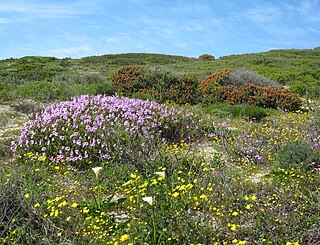
Cape Flats Dune Strandveld is an endangered vegetation type. This is a unique type of Cape Strandveld that is endemic to the coastal areas around Cape Town, including the Cape Flats.
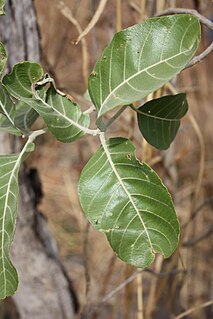
Combretum glutinosum is a shrub species of the genus Combretum, found in the Sahel belt in parts of Senegal, Burkina Faso, Ghana, Mali, the Gambia, Niger, Nigeria and Cameroon, across to parts of Sudan. It is known as dooki in Pulaar, Kantakara in Hausa, rat in Wolof and jambakatan kè in Maninka. Its synonyms are Combretum cordofanum Engl. & Diels, C. passargei Engl. & Diels, C. leonense Engl. & Diels.

Euclea pseudebenus is a tree native to Angola, Namibia and the Cape Province region of South Africa. It is classified as a protected tree in South Africa.

Euclea crispa, commonly known as the blue guarri, is an Afrotropical plant species of the family Ebenaceae. The hardy and evergreen plants may form a dense stand of shrubs, or grow to tree size. It is widespread and common in the interior regions of southern Africa, and occurs northward to the tropics. Though some are present near the South African south and east coasts, they generally occur at middle to high altitudes. It is readily recognizable from its much-branched structure and dull bluish foliage colour. Those bearing lanceolate leaves may however resemble the Wild olive, another common species of the interior plateaus.
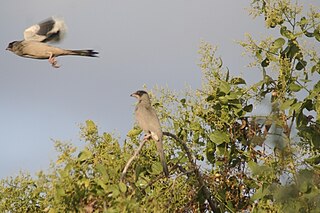
Pilu oil is an extract from seeds of the pilu tree, the meswak tree, and the mustard tree.

Euclea natalensis, the Natal guarri, is a dioecious African plant species of the family Ebenaceae. It occurs from Ethiopia and Somalia in the north, southwards to the Western Cape, South Africa. Its hirsute, leathery leaves have an opposite arrangement, and the flower sprays grow from the leaf axils. The spherical fruit appear from October to June.
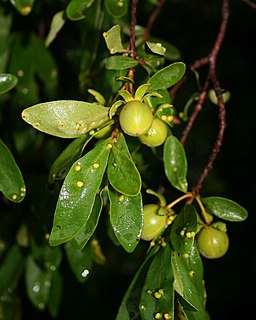
Diospyros lycioides, commonly called the bushveld bluebush, is a species of African Diospyros, trees and shrubs in the family Ebenaceae. It is native to central and southern Africa, except the winter-rainfall area. It grows in Australia and is known as a weed there. Many parts of the plant are used: the wood, the roots and stems for toothbrushes, the fruits for alcoholic drinks, and the roots and bark in traditional medicine.

















